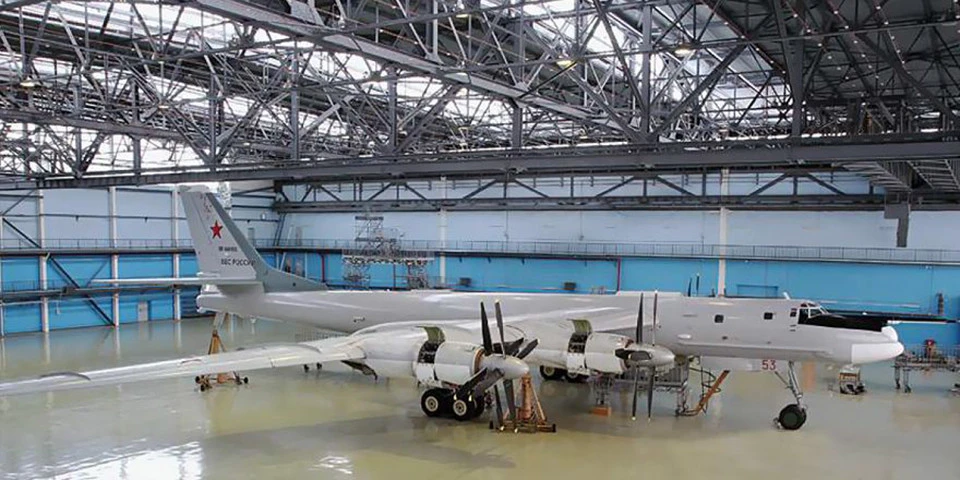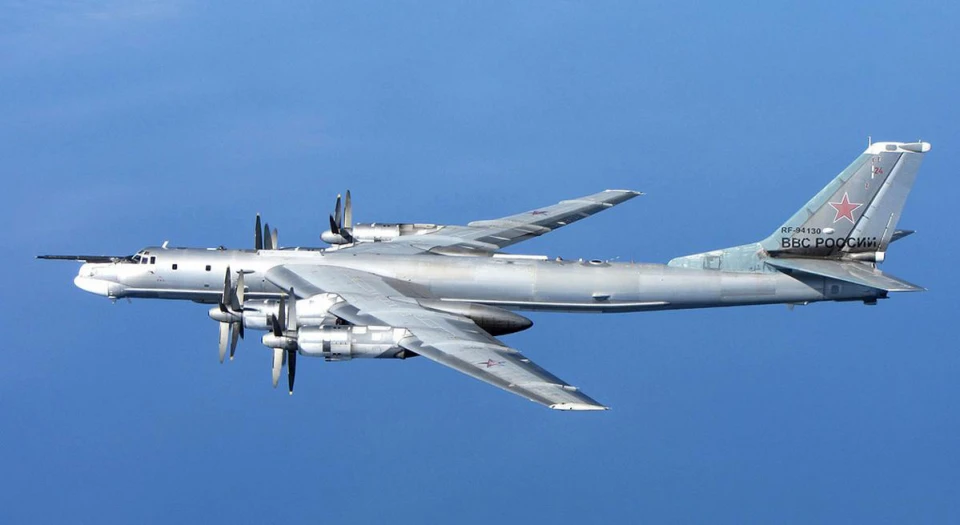
Tu-95MS: Ukraine scraps, Russia uses for terror - understanding Russia's most commonly used strategic bomber
On April 5, Ukraine launched a strike on Russian airfields. UAVs targeted three military airfields (in Yeysk, Kursk, Engels) and the Morozovsk airbase in the Rostov region, damaging at least three Tu-95MS bombers stationed at Engels airfield
Briefly what is in the text:
- What is the Tu-95MS and its history
- Tu-95MS technical characteristics
- Tu-95MS in Ukrainian Armed Forces service
- How Tu-95MS is used
- How Ukraine fights against Tu-95MS
- How many Tu-95MS are in Russia and how the Russians protect these aircraft
What is the Tu-95MS and its history
The Tu-95MS was developed based on the strategic bombers Tu-95. This aircraft was designed and put into service in the 1950s, forming part of the "nuclear triad" (Tu-160, Tu-95MS, and Tu-22M3) and becoming one of the symbols of the Cold War. Its main purpose was to destroy strategic targets deep in enemy territory under any weather conditions and at any time of day. The first aircraft from serial production were delivered in 1956. Interestingly, at that time, the Tu-95 were stationed at the Ukrainian airfield in Uzyn, located in the Kyiv region. From here, the aircraft patrolled the northern regions of the USSR, including the Arctic.
The Tu-95 is equipped with four turboprop engines NK-12, located in nacelle-like wings. Each engine is fitted with two coaxial metal four-bladed propellers.

Photo: from open sources
The Tu-95's four high-power engines make it one of the loudest aircraft in the world, negatively impacting its stealthiness. It can even be detected by hydroacoustic systems of submarines operating at combat depths.
Originally developed as a bomber, the Tu-95 evolved into a missile carrier during modernizations. After numerous updates, starting from the Stalin era aircraft, the Tu-95MS, a missile carrier capable of launching long-range missiles, was developed by the 1980s. In the MS variant, the aircraft can carry up to six Kh-55/555 cruise missiles. It is also capable of carrying up to eight Kh-101 missiles on external pylons. Additionally, the bomber received new communication systems, flight control, and other upgrades. Serial production of the Tu-95MS took place from 1982 to August 1992.
The Tu-95MS crew consists of seven members: aircraft commander, co-pilot, navigator, second navigator, communications operator, flight engineer, and weapons systems officer. The crew is accommodated in two pressurized compartments. Ejection seats for crew members are not provided. In case of emergency, evacuation is conducted through entrance hatches.
Tu-95MS technical characteristics
- Length - 49.6 m
- Height - 13.3 m
- Wingspan - 50 m
- Maximum takeoff weight - 185 tons
- Maximum speed - 830 km/h
- Cruising speed - 700 km/h
- Maximum flight altitude - up to 13 km
- Range - 10.5 thousand km without refueling
- Combat range - 6500 km
- Crew - 7 people
- Combat load - up to 20 tons
Tu-95MS in Ukrainian Armed Forces service
In 1991, following the collapse of the USSR, Ukraine inherited 19 Tu-95MS strategic bombers. In 1998, Ukraine began the destruction of the inherited strategic bombers using funds provided by the United States. Later, after negotiations, Ukraine transferred 11 strategic aircraft (including three Tu-95MC) to Russia supposedly in exchange for the write-off of part of the debt for gas. Three aircraft remained in Ukraine (one of them is currently an exhibit in the Poltava Museum of Long-Range Aviation), while the rest were scrapped.
At first, Ukrainian government circles mentioned a compensation figure of $650 million from Russia, which later decreased to $450 million. Ultimately, they settled for $275 million, but even that amount Russia did not pay to Ukraine, instead 'writing it off' as payment toward gas debts owed to Russian Gazprom.
"All of this was not transferred for money but for mythical energy debts that Russia claimed Ukraine and Naftogaz owed, which supposedly this transfer of bombers partially covered – at least in part. This is an example of 'successful' cooperation and trade with Russia. But considering that Russians are still utilizing Ukrainian strategic aviation today, we can clearly say that it was an absolutely dishonest financial assessment made by Russia, which was agreed upon by the Ukrainian officials of that time," explained Yuriy Kostenko, the first head of the government delegation in negotiations with Russia on nuclear disarmament in 1992-1993, in an interview with Radio Liberty.
President of the Center for Global Studies “Strategy XXI,” Mykhailo Honchar, recalls that the idea of transferring bombers was proposed by the then-chairman of the board of Naftogaz, Ihor Bakai.
“The idea was, 'Well, we have some scrap metal, and the Russians are willing to take it. Let's sell it and pay off the debts.' So that's what they did, and President Kuchma approved it all. He thought, 'At least we'll pay off some of the debts.' Then the aircaft and missiles went to Russia. Even then, there was a question whether we were giving the aircaft too cheaply, but the Russians squeezed us, basically saying, 'Want more? Well, we don't need these aircraft anymore. They'll be a bigger burden for you (Ukrainians)," noted Honchar.
By the way, Ihor Bakai left for Russia after the Orange Revolution, where in 2005 he obtained Russian citizenship.
How Tu-95MS is used
Tu-95MS strategic bombers are in service with the 184th Heavy Bomber Regiment (based in Engels), the 79th Regiment (Ukrainka in the Amur region) and the 182nd Guards Aviation Regiment (also Ukrainka).

Photo: from open sources
Despite its long history, until recently, the Tu-95MS was not practically utilized in combat conditions. Its official combat debut dates back to 2015 when the Russian Ministry of Defense announced missile launches by the “ninety-fifth” against Syrian territory.
In addition, the aircraft were often used for provocations and flights near the United States, Canada, Norway, and Japan. Russians were especially fond of flexing their muscles in front of the Americans, even sending them “greetings” via special channels. In all, in 2023 alone, NATO aircraft intercepted Russian aircraft over 300 times.
Today, Tu-95MS missile carriers are the backbone of Russia's strategic aviation. It is from these aircraft that the Russians most often fire cruise missiles at Ukrainian cities. These attacks can be massive. For example, on December 5, 2022, the head of the Mykolaiv Regional Military District, Vitaliy Kim, reported that the Russians had launched 14 Tu-95 bombers.
A massive attack was recorded on the night of March 9, 2023, when Russian troops fired 48 missiles from 10 Tu-95 strategic aircraft. In September of the same year, another strike by ten Tu aircraft was recorded. Then the Russians unusually loaded the aircaft (4-5 missiles per aircraft, not 1-2 missiles as usual). However, Ukrainian air defense successfully repelled the attack.
On the morning of December 29, 2023, Russian troops launched the largest massive missile strike against Ukraine during the full-scale war. In total, they launched 158 air targets. In particular, Russian forces launched at least 90 Kh-101/Kh-555/Kh-55 cruise missiles from 18 Tu-95MS bombers (the Armed Forces of Ukraine eliminated 87 of them). In February 2024, a dozen regions came under fire from Tu-95MS. During the year, at least 300 missiles were fired from the Engels airfield.
Defense Express pointed out that in the first months of the war, Russia used different bombers for attacks, but now it is mostly Tu-95MS that launches missiles.
“During the months-long campaign of missile strikes, the Tu-95MS bomber proved to be much more reliable and easier to maintain than the Tu-160. Therefore, the Russians prefer to use the Tu-160 for demonstrative 'intimidation actions,' while all the 'routine combat work' is carried out by the Tu-95MS," the article says.
How Ukraine fights against Tu-95MS
"Usually, in the case of an attack, it's said that for air defense, it's more effective to shoot down not the missiles, but their carriers. However, in the case of strategic bombers, this is impossible," emphasizes Defense Express.
“There is one problem - there are no long-range air defense systems in the world that could 'ge' the Russian Tu-95MS and Tu-160 at the frontiers of cruise missile launches, regardless of geography - whether it is the space over the Caspian Sea or the Kola Peninsula in general (from which the Russian aggressor fired cruise missiles during one of the recent strikes). In fact, why the issue of F-16 is so acute for Ukraine, because it is essentially a non-alternative way to strengthen the defense of our skies against enemy missile attacks,” the article says.
Unable to shoot down aircraft during missile launches, Ukraine takes every opportunity to damage bombers at their home bases. In particular, the Engels airfield, located 700 kilometers from Ukraine, has become a regular target for the Ukrainian Armed Forces, at a distance that can be reached by Ukrainian drones and other weapons.
Thus, on December 5, 2022, the TU-95MS was damaged for the first time in history as a result of hostilities. A few weeks later, there was a more powerful attack on the Engels. Even Russian sources reported three dead soldiers, noting that “the aircraft was not damaged.”
Instead, activist Volodymyr Zolkin, who is known for his videos with captured Russian soldiers, reported that five Tu-95MS were damaged, the control tower was destroyed, 17 Russian soldierss were killed, and 26 others were injured.
Defense Express, having analyzed satellite images, states that on December 26, 2022, there was “a significant number of aircraft that were most likely preparing for departure” at the Engels airfield. Observers believe that the damage to five Russian strategic bombers is realistic.
Although the then spokesman for the Ukrainian Air Force, Yuriy Ihnat, warned against overly optimistic assessments of the attack on the Engels.
“I can't (confirm), I can hardly believe it... When I saw this information, I was a bit surprised. Five aircraft at once? But they don't stand side by side on the same square meter or at any appropriate proximity to each other. Aircraft such as the Tu-95 are hundreds of meters away from each other... There is no need for wishful thinking,” he said on Radio NV.
However, since 2022, the situation with long-range weapons in the Defense Forces has improved, so attacks, in particular on Engels, have become regular. Thus, in early April, 19 aircraft were damaged in Russia as a result of drone attacks, including three Tu-95MS strategic bombers.
In addition, the OSINT agency Molfar managed to identify over 70 pilots and technicians of the Engels-2 air base. However, not all war criminals may live to see the day of trial. For example, in February 2024, Oleg Stegachev, a Tu-95MS strategic bomber crew commander involved in the attacks on Ukraine, was shot dead in the Russian city of Engels.
How many Tu-95MS are in Russia and how the Russians protect these aircraft
The Military Balance 2022 indicated that Russia had 60 Tu-95MS aircraft at the end of 2021. The Militarny portal estimates the Russian fleet, as of 2024, at 58 “ninety-fifths”: 31 Tu-95MS and 27 Tu-95MSM.
However, Defense Express experts emphasize that the actual number of combat-capable bombers of this type is much lower. They point out that only 90 Tu-95MS units have been produced over the 10 years of serial production.
"However, it is worth considering that currently, the maximum number of Tu-95MS aircraft raised into the air for strikes against Ukraine by the Russians is up to 20, and for joint flights with strategic aviation of the PRC in 2022, up to 10 aircraft at most. It seems that the conclusion here is that the actual number of combat-ready Tu-95MS aircraft amounts to a maximum of 50% of the total 'on paper' number," the material states.
Experts agree that Russia is currently unable to build new strategic aviation in significant quantities, which is why it carefully preserves its existing aircraft, often relocating “strategists” to airfields located as far away from Ukraine as possible. Interestingly, Tu-95MS aircraft are often based in Olenegorsk. This is literally just 150 km from the border with Finland and, consequently, from the NATO border, making the aircraft an easy target for any type of weaponry.
In addition, in order to disorient Ukrainians, the Russians paint pictures of bombers on their airfields. And they try to protect them with outlandish methods, such as covering Tu-95MS with car tires, which are supposed to save them from a kamikaze drone attack.
“At the same time, there is a great risk for the Russians, when the tires will only add fire in the event of another attack on a Russian airfield with tires on strategic bombers. In addition, if the occupiers decide to install tires on their aircraft en masse, they will have to dismantle such protection every time before the aircraft performs a training or combat flight, because it is clear that the aircraft will not fly with tires on the wings,” Defense Express comments on this know-how.
- News














































